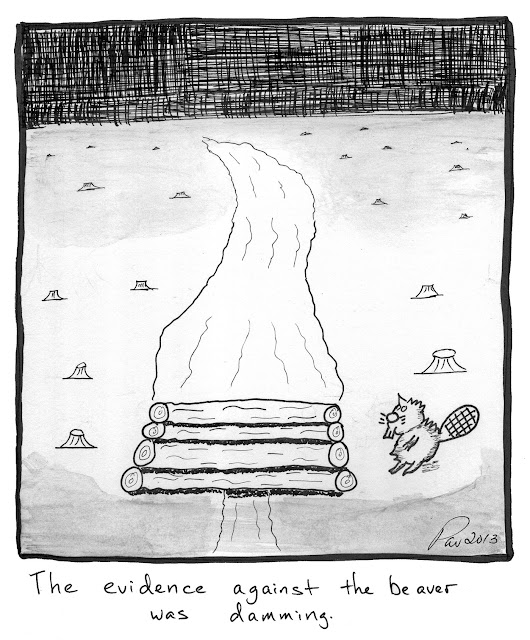What a wonderful event hosted by UAF Summer Sessions as part of their “Discover Alaska” lecture series. An responsive and enthusiastic crowd of over fifty folks who were very engaged and had a great sense of humor (always a bonus) came by for my 45-minute long show & tell on “25 Years of Cartooning in Alaska.” I especially appreciated the question & answer period afterwards and one-on-one followups - and always love it when people share their own funny stories.
The new Margaret Murie Life Sciences building up on the newly renamed Troth Yeddha’ part of UAF campus (aka West Ridge) still had that new-building smell and the auditorium boasted of state-of-the-art technological tools to professionally streamline the presentation. Note: If anybody who came early to the lecture happened to hear the laughing coming from the men’s room it was on account of how despite all the high-tech bells & whistles there still was a roll of toilet paper out on its side in the toilet stall... which immediately brought this panel to mind..
Linked to above is the "director's cut" of the talk, which I tweaked and edited + added bonus stills of the actual cartoons that are being discussed/laughed at. Wish I could cut out the cringe-worthy commentator... some people should just stick to drawing. But like a lot of bad books, still fun to look at the pictures.
This was a companion show & tell that dovetailed with the “Overflow XXV” exhibition currently on display at the Fairbanks Community Museum. I prefaced the lecture with the caveat (or warning) that there’d be something really funny, really stupid and really offensive for everyone… so not really all that much different from spending time with me normally. I did poke fun at the lecture series with a slide of the impressive roster of scientific luminaries and academic speakers which featured a Dr. after Dr. after Dr…. culminating with, wait - what… a cartoonist? But in all honesty it was was quite humbling and flattering to be tapped as the "grand finale" speaker! Technically it was also class time (note: whenever possible BYO cartooning class students as plants in the audience – it’s like having your own imported laugh track) so I honestly tried to lecture. But at some certain point it becomes much easier and better to just click through the cartoons and let them do the work – it’s probably the closest to stand-up that a sit-down comic gets.
 |
Here's a direct link to the unedited Summer Sessions YouTube of the lecture.
|
The obvious kickoff question to answer is what the title meant:“Overflow” is akin to “Nuggets” (implying something rare and of value) in that it’s a term that takes on different connotations in Alaska. Whether water or ideas, it's something that which arises from deep within as a result of the tremendous stress of intense freeze/thaw cycles in the dead of another long, dark, cold Interior winter. It’s an inspirational environment and mental state for an outsider to a community and region, and gave a great perspective for harvesting cartoon material, which has only deepened over a quarter-century of residency, along with the appreciation of subtle things that only locals can appreciate and relate to. This is, after all, a funny place, full of funny people that do funny things. And some topics just never grow old: outhouses, mosquitoes, the weather all make great fodder for gags.
Even though the presentation was ostensibly about my cartoons, I both started and finished with examples of other people’s work. This eclectic sampling of material started with my educational heroes as a current art teacher and also my artistic inspirations. From there we jumped off into my first published cartoon (1982 in Nottingham High-school’s “Meadowbrook”), moved to Alaska and saw the cover of Tundra Hippy Comics and early commercial work for Clinkerdagger, Bickerstaff & Pett’s, and the debut of FreezeFrame (with The Homesick Alaskan) in 1986 in the Heartland section of the Fairbanks Daily News-Miner. From there we wandered through a gradual evolution of stylistic shifts largely on account of materials and techniques: the FreezeFrame feature was marked by the use of Flair pens, Xerox printer paper and Zip-A-Tone; then the adoption of a computer as a tool began to assert itself, so digital shading and tell-tale vectored line becomes the dominant aesthetic; culminating with a return to basic drawing principles in Nuggets, with minimal Photoshopping of raster images, and wash and watercolor over the traditional pen & ink originals. I also took some time to talk a little about the creative process: from the conception of ideas, to doodles, pencils, inks to finished piece. Then a brief sampling of editorial panels followed, with a skip through my experiences in the Sequential Art department at SCAD and the hiatus in Maine, and also some examples of freelance work for a range of different clients.
Final mention was made on the importance comics as a way of instilling a sense of passion about reading, and a pitch for the Literacy Council of Alaska (note: added a "Literacy" tag for the "Topics" blog-post label list). One fresh example I gave was the mother of a young boy who came to my opening, bought the new book, and on the ride home he read aloud each cartoon to her – and wanted to go back to the gallery because he was almost done with the book and was going to run out of cartoons. Hearing about that sort of thing really, really makes my whole day.
And at the end, some of my favorites culled from the students of both the Visual Art Academy and the Cartoon and Comic Art course in UAF Summer Sessions. Because that’s where it’s at, and that’s what it’s all about.
Thanks again to UAF Summer Sessions and to all the folks who helped, and to all the friends and fans who came out for their support!





No comments:
Post a Comment